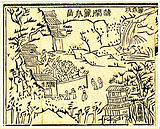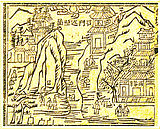
Guangzhou, also known as Canton, is the capital and largest city of Guangdong province in southern China. Located on the Pearl River about 120 km (75 mi) north-northwest of Hong Kong and 145 km (90 mi) north of Macau, Guangzhou has a history of over 2,200 years and was a major terminus of the maritime Silk Road; it continues to serve as a major port and transportation hub as well as being one of China's three largest cities. For a long time it was the only Chinese port accessible to most foreign traders. Guangzhou was captured by the British during the First Opium War and no longer enjoyed a monopoly after the war; consequently it lost trade to other ports such as Hong Kong and Shanghai, but continued to serve as a major transshipment port. Due to a high urban population and large volumes of port traffic, Guangzhou is classified as a Large-Port Megacity, the largest type of port city in the world. Due to worldwide travel restrictions at the beginning of the COVID-19 pandemic, Guangzhou Baiyun International Airport, the major airport of Guangzhou, briefly became the world's busiest airport by passenger traffic in 2020.
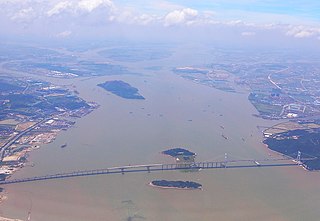
The Pearl River, is an extensive river system in southern China. "Pearl River" is often also used as a catch-all for the watersheds of the Pearl tributaries within Guangdong, specifically the Xi ('west'), Bei ('north'), and Dong ('east'). These rivers all ultimately flow into the South China Sea through the Pearl River Delta. Measured from the farthest reaches of the Xi River, the 2,400-kilometer-long (1,500 mi) Pearl River system constitutes China's third-longest, after the Yangtze River and the Yellow River, and its second largest by volume, after the Yangtze. The 453,700 km2 (175,200 sq mi) Pearl River Basin drains the majority of Guangdong and Guangxi provinces, as well as parts of Yunnan, Guizhou, Hunan and Jiangxi; it also drains the northernmost parts of Vietnam's Northeast Cao Bằng and Lạng Sơn provinces. The Pearl River is famed as the river that flows through Guangzhou.
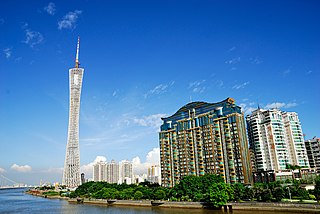
Haizhu District is one of 11 urban districts of the prefecture-level city of Guangzhou, the capital of Guangdong Province, China.
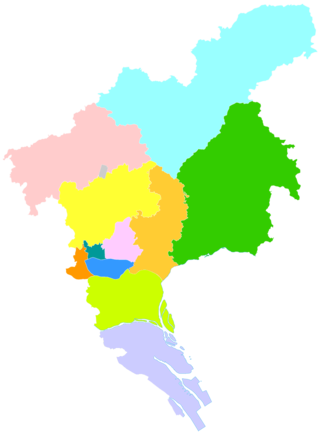
Tianhe District is one of the eleven districts of Guangzhou, the capital of Guangdong province. In Chinese, the name Tianhe literally means "a river in the sky/heavens", which is also a Chinese name for the Milky Way. It is bordered by Yuexiu District on the west, Baiyun District on the north and Huangpu District on the east. Haizhu District is on its south, though they are separated by the Pearl River.
Zhujiang Brewery was established in 1985 and is a large state-owned enterprise which deals mainly in beer and related products such as labels, cartons, crates, etc. The brewery is one of the largest single site production facilities in the world, and produces Zhujiang Beer.
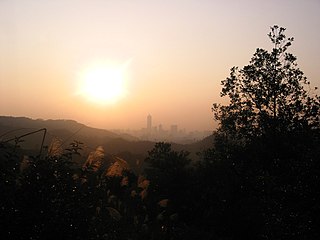
Baiyun Mountain, also known as White Cloud Mountain, is a mountain located a few miles to the north of Guangzhou, China. It has a height of 427 metres (1,401 ft).

Yuexiu District is one of 11 urban districts of the prefecture-level city of Guangzhou, the capital of Guangdong Province, China, located west of the Tianhe District and east of the Liwan District. It is the commercial, political and cultural centre of Guangdong and noted for its high-quality education. The Guangdong provincial government and the Guangzhou city government are both located in the Yuexiu District. Established in 1960, the district absorbed the former Dongshan District in May 2005 along with several former subdistricts of the Baiyun and Tianhe district. Yuexiu District has 18 streets under its jurisdiction. The total area is 33.8 square kilometers. According to the seventh census data, as of 0:00 on November 1, 2020, the resident population of Yuexiu District was 1,038,643.

Liwan District is one of 11 urban districts of the prefecture-level city of Guangzhou, the capital of Guangdong Province, China. The district is split into two parts by the Pearl River: Xiguan in the northeast and Fangcun in the southwest.

Haizhu Square is a public square located in Yuexiu District, Guangzhou, China. It is located on the riverfront. Its centrepiece is the Guangzhou Liberation Statue, erected in 1959. In 1963 the square and its environs were named as one of the Eight Sights of Guangzhou.

Canton Tower Station is an interchange station on Line 3 and Zhujiang New Town Automated People Mover Systems of the Guangzhou Metro. It started operations on 28 December 2005. It is an underground station located to the south of Binjiang Road East in Haizhu District, on the south bank of the Pearl River.

Guangzhou Bridge is a bridge crossing the Pearl River in Guangzhou, Guangdong province, China.
Huanan Bridge is a bridge crossing the Pearl River in Guangzhou, China.
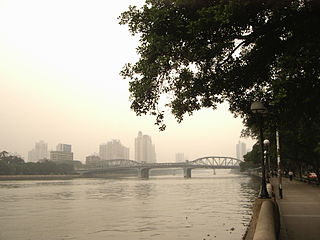
Haizhu Bridge is an iron bridge across the Pearl River in Guangzhou, China.
Pazhou Bridge is a bridge in Guangzhou, Guangdong, China. The bridge connects Tianhe District across the Zhujiang River to the southern district of Huangpuchong in Guangzhou.

Mount Xiqiao is a 40- to 50-million-year-old extinct volcano situated in the south west of the Nanhai District, Foshan, Guangdong, People's Republic of China 68 km (42 mi) from Guangzhou. The mountain is an important scenic area and designated as a national forest park and national geological park. Covering an area of 14 square kilometres (5.4 sq mi), the area features a total of 72 peaks with the highest, Dacheng Peak (大秤峰), rising to 346 m (1,135 ft).
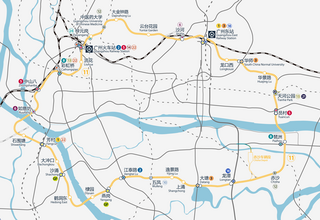
Line 11 of the Guangzhou Metro is a rapid transit rail line under construction in Guangzhou. It will be a loop line around the city center, connecting Guangzhou railway station, Guangzhou East railway station, Pazhou, and Fangcun.
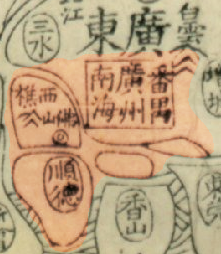
Sanyi or Nanpanshun, also known by Cantonese romanizations such as Sam Yup and Nam Pun Shun, refers to the three districts of Nanhai, Panyu and Shunde surrounding Guangzhou and Foshan in Guangdong, China.
The following is a timeline of the history of the Chinese city of Guangzhou, also formerly known as Panyu, Canton, and Kwang-chow.











